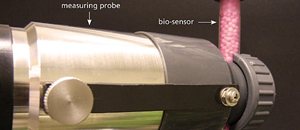The most important function of the water supply networks is to ensure that the supplied drinking water is free from harmful pathogens and other contaminants. This is precisely, the reason why water is subjected to a lot of tests regularly before it reaches people.
The AquaBio Tox project in Germany has been created with the aim of constant monitoring of drinking water. Currently, the German Drinking Water Ordinance are restricted to random samples for testing; as a result the findings are out after many hours and sensitive to only some contaminants.
 AquaBio Tox System
AquaBio Tox System
The AquaBio Tox system employs a bio-sensor that detects a broad range of contaminants in just minutes. A small quantity of water is diverted towards the sensor from the mainline. The sensor consists of two strains of bacteria and mammalian cells. These bacteria cells sample a large amount of water due to the large surface and react to toxins immediately. The bio-sensor is capable of detecting very minute quantities of toxins. The sensor was put to test by the Fraunhofer Institute for Interfacial Engineering and Biotechnology IGB in Stuttgart, Germany. They found out that the sensor successfully showed reaction to a wide range of substances.
The sensor emits a red fluorescence due to micro-organisms in it, when a toxic substance comes in contact the fluorescence changes. The Fraunhofer Institute of Optronics, System Technologies and Image Exploitation IOSB have developed an ultra sensitive camera that detects the smallest change in fluorescence and performs toxic analysis. The monitoring unit stores the data of the previous toxin detection and analysis hence sets off an alarm if an unusual pattern is detected.
The sensor requires most favourable living conditions for the micro-organisms to operate the bio-sensor permanently. Hence, IOSB has designed a system that monitors and adjusts parameters like temperature and inflow of nutrients to the sensor automatically. Efforts are being taken to design the AquaBio Tox to be compact and cost -effective so that hassle free installation is possible at important points in the drinking water supply chain.